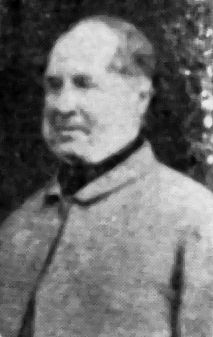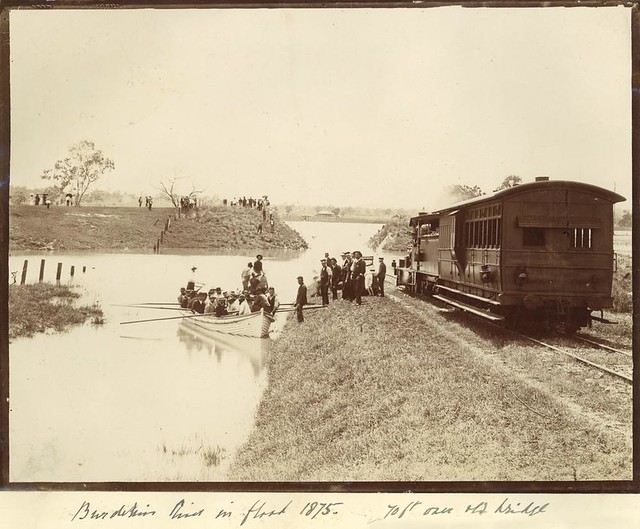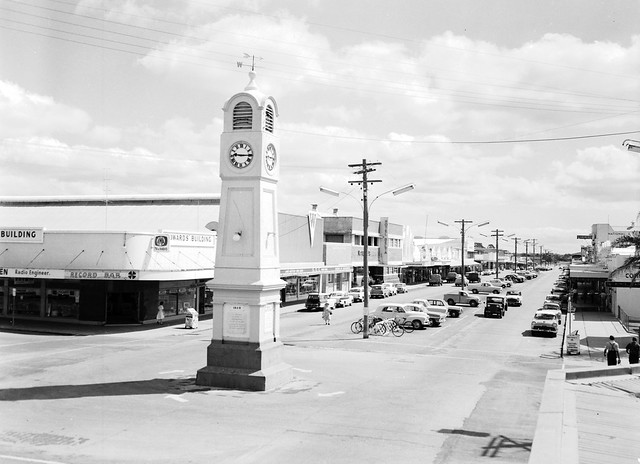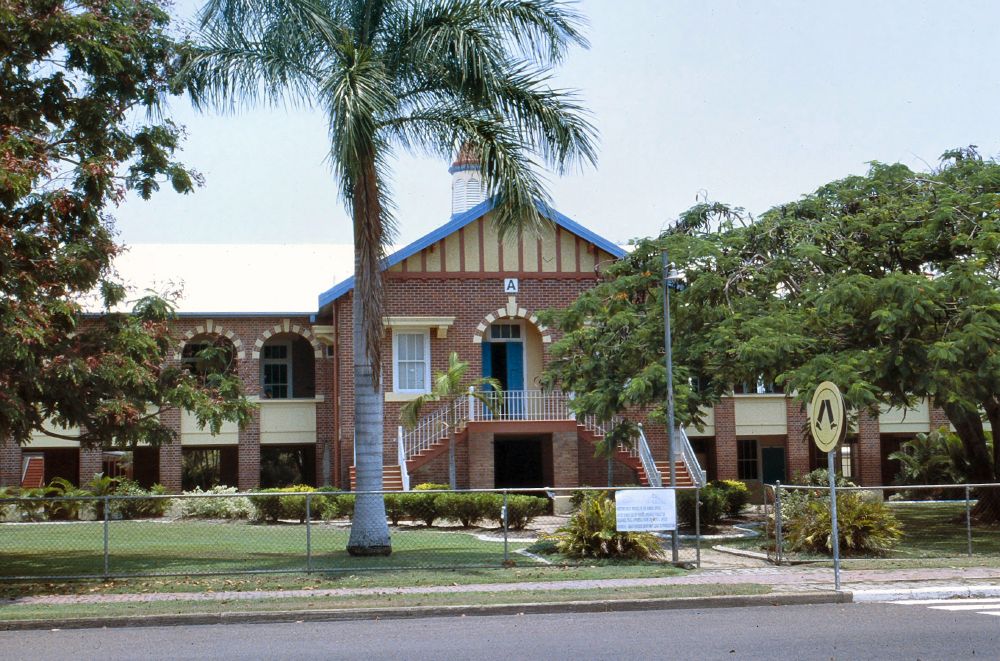Situated on the north side of the Burdekin River, 1270 km north of Brisbane, and 85 kilometres south of Townsville, Queensland, the town of Ayr is surrounded by fields of sugarcane.
The town of Homehill, which is on the other side of the Burdekin River, was established in the 1900s and may have been named after a hilltop
defended by the British Army in the Crimean War. Home Hill was originally part of the Inkerman Downs Station.
The Bindal Aboriginal People
Birri-Gubba is the language spoken by the Bindal People.
The Bindal and Juru Aboriginal people have
traditionally lived in the district around today's Ayr.
The Bindal people, according to Norman Tindale, occupied land from the mouth of the Burdekin River, north to Cape Cleveland and inland to Leichhardt Range. The territory of this clan extended up towards Townsville, where sacred sites and
Aboriginal rock art can be found.
Bindal people have documented the presence of rock art at Cape Ferguson, and drawings of circles representing shields, initiation and bora rings.
Behind Plantation Park, in Ayr, there is an important link to the Burdekin’s Aboriginal history. A walk winds its way through what is believed to be the Burdekin’s last remaining remnant rainforest, which includes a bat settlement and lagoon.
In 1886, Edward Micklethwaite Curr published a book called,
The Australian Race: Its Origins, Languages, Customs an on the Aboriginal people, their habits and their dialects. This book was compiled from reports of settlers, missionaries and others. The Burdekin River Aboriginal people mentioned are believed to be three distinct language groups, inclining the Bindal.
Here
 |
| Lengths of bone and wood were worn as nose pieces (“nose bones”) by Aboriginal people. Image from page 143 of "Our journey around the world; an illustrated record of a year's travel of forty thousand miles.." (1894) |
 |
| Aboriginal camp, North Queensland, 1896, State Library of Queensland |
 |
| Aboriginal Australian outside their dome shaped homes - circa 1910, Aussie Mobs |
 |
| Gubulla Munda Totem at Plantation Park, Ayr, mark the remains of Birri Gubba ancestors |
1839
The first European to visit the Burdekin River was Captain Wickham in H.M.S. Beagle in 1839, surveying the north-western and other portions of the Australian coast.
Captain Wickham named the river the Wickham River. However, the river's name was changed to Burdekin by
the explorer Ludwig Leichhardt, in 1849, after Thomas Burdekin, one of the sponsors of Leichhardt's expedition.
 |
| Picture of John Clements Wickham |
The corvette
HMS Fly under the leadership of Francis Price Blackwood, a naval office, surveyed and charted the Torres Strait, New Guinea, and the east coast of Australia in 1842. Harden Sidney Melville, an English painter, illustrated naturalist Joseph Beete Jukes’ official narrative of the
Fly’s voyage.
 |
| Drawing entitled Interview with Natives of Wickham River by Harden S. Melville |
1846
A 22-year-old English sailor named James Morrell was shipwrecked in 1846 and was rescued by a clan of the Bindal people near Bowen and Cardwell, to the south of Ayr.
Read here
1850s
6th June 1859, Queensland
becomes a self-governing Crown colony.
In 1859, Henry Daniel Sinclair, James Gordon and Ben Poole sailed about 8 miles up the Burdekin River .
"October 1.— At daylight Ben and I went
ashore to obtain water showed us yester-
day. When we arrived four natives were
awaiting us armed with spears and nulla-
nullas. We did not much like their ap-
pearance, and they would not lay down
their arms. We gave them two bouilli
tins to bring us water in, and in order to
see how they shaped. They retired a short
distance, and pretended to bring them back
full, but we discovered they were empty.
Then they went a little way behind a rock,
and filled them with salt water, and emp-
tied it as we did, which showed of rascality
and treachery; and as we moved away
they laid hold of the boat and attempted
to drag her into a small inlet, when we
raised our firearms, which they evidently
knew well, and they let go. We then
pushed off, and immediately more natives
fully armed rushed out of the bushes, and
commenced howling and dancing, and ran
into the water after us like madmen. This
fully convinced us of their intentions, and
we considered ourselves fortunate in not
going ashore, as Ben and I would have
gone for water had only a few natives
made their appearance. In the evening
aboard the captain was savage that we did
not fire upon them, and wished to return
with us ashore again, but we declined."
Queenslander (Brisbane, Qld. : 1866 - 1939)
In 1859 George Dalrymple led an expedition to the Burdekin River area. There were two skirmishes with a large group of resident Aboriginal people. Dalrymple
returned to the region in 1862.
1860s
Pastoral runs were taken up in the Lower Burdekin in the early 1860s.
Edward Spencer Antill (a son of colonist Henry Colden Antill) in 1861, selected a large area of land along the lower Burdekin River for a sheep station which he named Jarvisfield.
Attempts were made from 1863–1864 to establish a port called Wickham on the north bank of the Burdekin River. Various issues, including problems with mosquitoes, were encountered. Captain Wickham had noted that the river had two very shallow entrances, and the river banks were prone to flooding.
In 1864, inland from the entrance to the Burdekin River, the town of Wickham was established, on Rita Island near the river mouth. Although, the settlement was swept away by floods not long afterwards.
Ayr was later named after the Scottish town of the same name, as the original Ayr was the birthplace of Thomas McIlwraith, Queensland's Premier when the town was gazetted in 1882. Settlers had, however, been moving into the region since the 1860s.
"It appears that one of the men on Jarvisfield Station, while washing
himself at the river bank, a few days since, was
suddenly dragged in by an alligator—the mon-
ster seizing him by the arm, and stripping it to
the bone, besides inflicting two severe wounds
on the breast. Notwithstanding the pain the
man must have endured, he had the presence of
mind to commence shouting and splashing,
which scared the monster away, and he suc-
ceeded in reaching the bank in safety, although
weak from the loss of blood. He made his way
to the station where he now lies in a very
dangerous state."
In 1869, Alexander Stuart and others attempted to grow sugar cane, but there were problems with rainfall.
Freshwater lagoons in the Burdekin Delta were discovered and so could be used for irrigation. This made sugar cane viable.
Mounted Native Police detachments, of about six Aboriginal troopers, led by a European officer, were sent to the region. The Native Police are considered by some historians to be the major cause of death of Aboriginal people in the colony.
 |
| Native Police, Rockhampton, 1864 |
Queensland frontier violence is believed to be the worst in Australia.
[72][73] The most reports of shootings and massacres of Aboriginal people, the three deadliest massacres on white settlers, the most disreputable frontier police force, and the highest number of white victims to frontier violence on record in any Australian colony.
[74] Native Troopers were recruited from districts at a distance from those in which they are likely to be employed. (
1.) Aboriginal people were often hostile towards Aboriginal peoples
more distant.
1870s
In the 1870s, Jarvisfield Station was bought by Robert Towns and Alexander Stewart.
A 3 ft 6 in (1,067 mm) gauge tramway was established at the Pioneer Mill near Ayr in 1875.
 |
Burdekin River in flood, Ayr, QLD, 1875
|
The Great Northern Railway commenced in 1877.
In the 1870s R. W. Graham of Lilliesmere and A. C. Macmillan of Airdmillan
started growing sugarcane on the lower Burdekin.
1880s
Ayr was surveyed by Ellis Lymburner in 1881-2.
A primary school
was established at Ayr in 1886.
 |
| Mr G G Kann's premises next to Delta Auction. Mr Kann established his saddle and harness making business in 1884. Burdekin Library |
 |
| Carters Blacksmith Store, Ayr, no date, SLQLD |
 |
| 1. Early view of Queen St Ayr, 2. Opposite view of Queen St Ayr, Townsville Daily Bulletin (Qld. : 1907 - 1954) |
Robert Towns, who gave his name to the City of Townsville, also, first introduced the "Kanakas" to Queensland (South Sea Islanders), to work on sugar plantations.
Sugar growing had started in the Burdekin in about 1879 and the first sugar mill, Airdmillan estate, was established in 1883, by A. C MacMillan, who was one of the first selectors
for land. A. C. MacMillan and R. W. Graham later formed the Delta Sugar Company.
The success of the sugar crops, however, were impacted by periodic periods of dry weather in the Burdekin Delta, until underground water was successfully extracted in the late1880s.
 |
| Early Ayr, QLD, railway station with separate toilet building. Large number of horse and buggys also visible. Passenger and goods train is at the station. Burdekin Library, no date |
Also, in the 1880s, the Queensland Government passed legislation that would block the use of South Sea Island labour in the sugar industry by 1890.
Sugar plantation owners looked about for other sources of labour. One Townsville businessman, C.V. Fraire, who had emigrated to Queensland from Italy in 1872, travelled back to Italy to recruit agricultural workers for sugar plantations.
Italian workers arrived in Queensland in early December 1891, on the ship
Jumna. 266 of these immigrants were then sent to sugar plantations throughout the Herbert and Burdekin districts. (
Trisha Fielding).
 |
| South Sea Islanders planting sugar cane at Seaforth Plantation at Ayr, Queensland, circa 1900, State Library of Queensland |
 |
| Ayr Show, Mr W. Craig's pair of buggy horses, North Queensland Register (Townsville, Qld. : 1892 - 1905), Monday 3 July 1905 |
 |
| Canecutters at Ayr, QLD, ca. 1907, State Library of Queensland. Probably Olsen's gang at work in the cane here. |
Burdekin Delta Cinema opened on 23rd September 1910.
The Inkerman Bridge over the Burdekin River from McDesme to Home Hill was built in 1913.
WWI
 |
Members of the Ayr Light Horse. Some members unidentified. Bob Fielding, N. Newman, M. Leibrecht, L. Grey, B. Evans, G. Olsen, ?, C. Grey, ?, ?, Conley, ? Circa 1912, Burdekin Library
|
In 1912, Jarvisfield near Ayr opened 17 blocks of land for selection. One purchaser, Thomas Jones, bought 110 acres for £825, while Alexander Simpson paid £600 for his 110 acres.
 |
| McKimmon & Richardson store, Ayr, Queensland, 1912 |
Jarvisfield State School opened on 29 March 1915.
Ayr was the 6th Queensland
town to have Electricity in 1915.
John Henry Huggins (Senior) was an Aboriginal stockman who enlisted in 1916. John departed Australia on 4 May 1916. He served a year overseas on the Western Front, and then, was injured and hospitalised twice in Belgium. John survived WW1 and lived in Ayr.
 |
| Cane-cutters hut on a farm in Far North QLD, circa 1914 |
 |
| Railway station, Ayr, Queensland, 1914. State Library of QLD |
 |
| Large crocodile which was killed in a canefield near Ayr, 1917 |
 |
| The Presbyterian church was built in Ayr, QLD, in 1903. Services were held every Sunday evening. In 1910 a new manse was built beside the church and Reverend J. Kirke came from Bowen to start the full time ministry, circa 1918, Burdekin Library |
 |
| The Delta Theatre was built next to the Delta Hotel by the hotel owner Dave Edwards in 1910. It was also known as the Olympia Theatre. Model T Ford cars are parked at the front of the theatre. Ayr, QLD, circa 1918, Burdekin Library |
 |
| The main street of Ayr, still made of dirt. There are several horse and buggies in the street and a few cars. Local stores line both sides of the street. The original Queens Hotel situated on the corner of Queen and Edward Streets is on the right hand side of the image. Circa 1918, Burdekin Library |
1920s
 |
| The only complete Aboriginal team in Australia. They live round the Ayr distiict, and stand a good chance of being premiers this season. A white man, J. Horan acts as coach and secretary. The Queenslander (Brisbane, Qld. : 1866 - 1939) 1920, September 4) |
Interestingly, because of a civil war and high unemployment, thousands of F
innish emigrants journeyed to North Queensland seeking cane cutting jobs from the 1920s.
 |
A number of people on and around the main grandstand at the Ayr Racecourse. Ayr Racecourse Reserve was proclaimed on 2 June, 1887. Circa 1920, Burdekin Library
|
In 1922 the Home Hill Powerhouse was built.
 |
| Telegraph (Brisbane, Qld. : 1872 - 1947), Saturday 8 December 1923 |
 |
| Panorama of the main street of Ayr, Queensland, ca. 1926, State Library of Queensland |
 |
| The Commercial Hotel was built in 1926 in Queen Street, Ayr, QLD. At the time of the photograph it was known as Harding's Commercial Hotel. The Coutts Group accquired the hotel. Ayr Burdekin Shire Council Library Services |
 |
| Group of people outside the Country Women's Association rest room in 1927. The Ayr branch was established in 1923 and opened its own rest rooms four years later. Ayr, QLD, 1927, State Library of Queensland |
 |
| Lennon's Store, Queens Street, Ayr,QLD, n.d. |
 |
| Panorama of the main street of Ayr, Queensland, ca. 1926, State Library of Queensland |
 |
| View of Queen Street, Ayr. Horse and buggy, bicycles and motor vehicles can all be seen in the street. McKimmin & Richardson's store and other businesses visible along the street. ND. Burdekin Library |
The Ayr Town Clock was built in 1928 to commemorate John Drysdale who invented the method of tapping the underground water supply in the Burdekin Delta.
1930s
During the 1930s Depression, a government works scheme
was established to create employment.
On October 3 1932, a young, 19-year-old woman named Jean Morris was murdered in Ayr. Her killer had brutally stabbed her 43 times with either a dagger or a stiletto knife.
Jean was dressed in a silk nightdress when her body was found the following morning. Based on the ferocity of the assault, and choice of the weapon, the local police concluded that the murderer was a foreigner.
They suspected that crime gang leader Vincenzo Dagostino had ordered one of his associates to kill Jean because she would not have sex with him. And also to stop Jean from talking about his criminal activities. Dagostino was arrested in Italy, but he hanged himself while in jail.
 |
| Beautiful Dark-Eyed Jean Morris. Truth newspaper, 16 October 1932 |
 |
This photograph shows the settlement built entirely of petrol tins on Plantation Creek, AYR, QLD. It houses many of the rank-and-file movement. Here is situated rank-and-file head' quarters or, to quote the words of the district: 'Con O'Clurckin's joint.' A dispute on the Lower Burdekin cane fields, arising out of the desire of the A.W.U. and its members to abolish wage rates for contract rates, Sunday Mail (Brisbane, Qld. : 1926 - 1954), Sunday 7 July 1935 |
Ayr State High School was built from 1935 to 1937.
 |
| The new larger Masonic Hall, Ayr, QLD, had been built next to the old hall which was still in the process of being demolished. A car is parked out the front of the building, circa 1936, Burdekin Shire Library Service |
 |
Sugar cane train, Kalamia, Ayr, c 1938, Queensland State Archives
|
 |
| Early tractor towing loaded wagons of cane. The caterpillar tractor replaced horses. Ayr, QLD, 1939, State Library of Queensland |
1940 and WWII
 |
| Firefighters from the Ayr Fire Brigade standing in front of fire engine. B.Horan, unidentified, D. Curtis, C. Mulcahy, P. Carlson, J. Currie, S. Porter, J. Edwards, T. Shannon, unidentified, F. Clavili. Burdekin Library, 1939-1942, Ayr QLD |
During World War II
many Italian migrants were imprisoned in large detention camps. One man, Salvatore Previtera, an Italian canecutter from Ayr, was interned in 1942, and his wife, the mother of two young children, had to cut the cane by hand, herself. (
read here).
 |
| W. J. Law, a farmer from Katoora, erected Ayr's first public baths in Queen Street in 1931. After World War II the local council bought the Ayr pool and appointed J. O'Connor as lessee. This was not an Olympic size pool. Ayr, QLD, circa 1940, Burdekin Library |
"In the early hours of Saturday morning,
a well known Ayr resident, John Huggins,
aged 58 years, passed away quietly in his
sleep. Deceased, a returned soldier of
the last war, was paid fitting tribute by
this fellow Diggers, who formed a guard
of honor at the church, and later at the
graveside. The funeral moved from All
Saints Church of England at 4 p.m."
Townsville Daily Bulletin (Qld. : 1907 - 1954), Thursday 3 September 1942
John Henry Huggins (junior) enlisted in Ayr, and was sent to Burma. He became a prisoner of war on Burma/Thailand Railway. He was the first Aboriginal man to work in the Ayr Post Office.
"Jack Huggins, of Ayr, who has been
a prisoner of war in Japanese hands
since the fall o Singapore, has despatched a cable to his mother from
Rangoon, stating that he is safe and
well, and hopes to return home soon."Townsville Daily Bulletin (Qld. : 1907 - 1954), Monday 24 September 1945
Douglas Graham Butterworth from Ayr was a RAAF front gunner with Yorkshire-based 460 Squadron when his Wellington bomber ditched in the North Sea off Holland in 1942. He managed to get himself out of his wrecked plane, swim for three hours. He was then picked up by the Germans. Butterworth was a prisoner of war in Germany for three years (
read here).
Not so lucky, Thomas Ellis Jones of No 450 Squadron RAAF, who hailed from Jarvisfield, went missing on operations on 26 June 1942, during aerial combat in the Middle East. He has no known grave and is memorialised on the El Alamein memorial in Egypt.
 |
| Thomas Ellis Jones of No 450 Squadron RAAF, of Ayr, Qld |
 |
| Studio portrait of an Aboriginal serviceman, 50246 Trooper (Tpr) William (Willie) Allen, 11th Light Horse Regiment.Allen worked for William Galloway on his cane farm "Bellview", at Ayr in north Queensland. |
The Charlie's Hill Radio Direction and Ranging (RADAR) Station, just south of
Home Hill, was constructed in 1943 as part of Australia's World War II defences. The RADAR station was constructed by the Royal Australian Air Force (RAAF).
Remains of the radar-station comprise two above ground semi-circular igloos, two spotter's posts, tower foundations and miscellaneous concrete foundations. Edna Marion Southward from Ayr was one of the
WAAAF's based at the 211 Radar Station near Home Hill.
 |
A.C.W. Edna Southward, eldest daughter or Mr. and Mrs. R. C. Southward, of Munro Street Ayr,
Who with A.C.W. Marjorie Crawford, of Innisfail topped a recent telegraphy class in Victoria, and renewed her telegraphist's badge. Townsville Daily Bulletin (Qld. : 1907 - 1954), Thursday 14 January 1943
|
 |
| Ana Branch School, Ayr, QLD, about 1940s. JM |
 |
The new 63 bed hospital was officially opened in 1945 to replace the former hospital which had become overcrowded. The hospital was designed by J. P Donoghue and C. W. Fulton of Brisbane and built by Gilion and Murray of Brisbane. It had two storeys with three in the centre. It was designed to catch the breezes, with ample windows and cantilevered balconies. Circa 1945, Burdekin Shire Library
|
 |
| Townsville Daily Bulletin (Qld. : 1907 - 1954), Thursday 7 March 1946 |
 |
| Home Hill Power Station was used to pump water from the Burdekin Delta for irrigation, QLD, circa 1946, SLQLD |
1950s
 |
| Home of the Johnson family of Parkside, Ayr, 1950s. (J.M) |
 |
| Main Street, Home Hill - 1950s perhaps — in Home Hill, Queensland. Aussie Mobs |
 |
Townsville Daily Bulletin (Qld. : 1907 - 1954), Saturday 28 April 1951
|
 |
| Postcard of Ayr, 1950s, Vintage QLD |
 |
| Townsville Daily Bulletin (Qld. : 1907 - 1954), Friday 8 May 1953 |
 |
| Townsville Daily Bulletin (Qld. : 1907 - 1954), Friday 2 May 1952 |
 |
| War Memorial Hall, Home Hill - 1950s? — in Home Hill, Queensland, Vintage Queensland. |
 |
| Keith Pearce, with cane knife and cane, shows Pam and Edward Pearce how to top the cane, Ayr, Queensland, 1952 (Z638-22). ANU |
 |
| Janet and Pam Pearce watch a burning cane field at Ayr, Queensland, 1952 (Z638-22). ANU |
 |
| Home Hill Rodeo, QLD, 1954 |
1960s |
| Queen Street, Ayr, circa 1962. Public domain |
 |
| Home Hill Harvest Festival 1963, QLD |
1970s
The Burdekin Falls Dam (south-west of Ayr) is completed in 1987, with a capacity four times that of Sydney Harbour.
 |
| Malpass Hotel, Home Hill, Qld, after Cyclone Aivu, 1989.The damaging effects of the cyclone included a 3m storm surge at Wunjunga on Upstart Bay, causing the destruction of holiday homes and one death when an elderly man drowned after his caravan was swept away. With wind gusts around 180km/h, Tropical Cyclone Aivu caused serious damage to over 50 houses and other buildings at Ayr, Home Hill and Clare and $M90 damage occurred to sugar cane crops alone. Home Hill, QLD, 1980, Jan Smith |
Found at The Dump
Found In The Dump! Read about how the above photo was found at the shop attached to Stanthorpe Dump
here |
| Amelia and Thomas Jones from Jarvisfield, Ayr |
Around Ayr
 |
| Radar Station, Charlie's Hill, Ayr, QLD |
 |
| Ayr Court House, built from 1935 to 1941, Ayr, QLD |
 |
| Ayr State High School, circa 1937, Ayr, QLD |
 |
| The original Queens Hotel was established in 1883, Ayr, but burnt down in July 1902. Rebuilt and Cyclone Leonta damaged upper part of building. Burnt down in 1935. Rebuilt 1936. Ayr, QLD |
 |
| Grand National Hotel, Ayr, Queensland established in 1901, Ayr, QLD |
 |
| This clock, Unveiled in January 1930, commemorates John Drysdale who built the Inkerman Mill. John Drysdale was also the great uncle of artist Sir (George) Russell Drysdale. Post office behind. Ayr, QLD |
 |
| Masonic Temple, Ayr, Qld, circa 1935 |
 |
| Old National Bank building opened in 1935, Ayr, QLD |
 |
| Burdekin Shire Council Chambers, 145 Young Street. Ayr, Qld, built 1917 - 1939 |
 |
| Former Delta Cinema, circa 1930, Ayr, QLD |
 |
| Queenslander, Burke Street, Ayr, QLD |
 |
| Wickham Street, Ayr, Qld |
 |
| Queensland style house, Home Hill Road, Ayr, QLD |
 |
| Kalamia Hotel, Ayr, Qld |
 |
| Graham Street, Ayr, Qld |
 |
| Art Deco, Queen Street, Ayr, QLD |
 |
| Ayr, QLD |
 |
| Queens Hotel, Ayr, QLD |
 |
| Ayr Post Office, QLD |
Things To Do and Places To Go

















































































